Exercises (1559)
Extension and flexion of one leg in push-up position alternating ► mountain climber
Power
Individual work
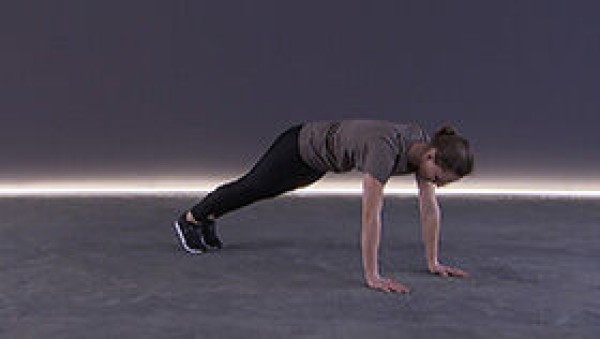
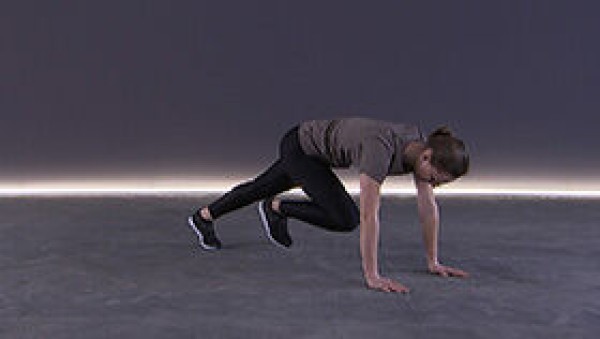

Push-up position (high support, face/look down), alternately bend one leg and lift it slightly off the floor (bring your knees between your arms).
Attention:
Keep your upper body as stable as possible, no hollow back (tense your stomach).
Lighten:
Just hold the basic position (push-up position); barely lift your leg off the floor and/or move it less forwards.
Harden:
Additional weight on the legs; unstable base (for the arms).
Variant:
Bring your knee diagonally (crosswise) to the opposite arm.
2 weight cuffs ► to make the exercise more difficult (additional weight)
1 balance cushion/balance board ► to make the exercise more difficult (unstable surface)
Extension and flexion of one leg in push-up position alternating ► mountain climber
Power
Individual work
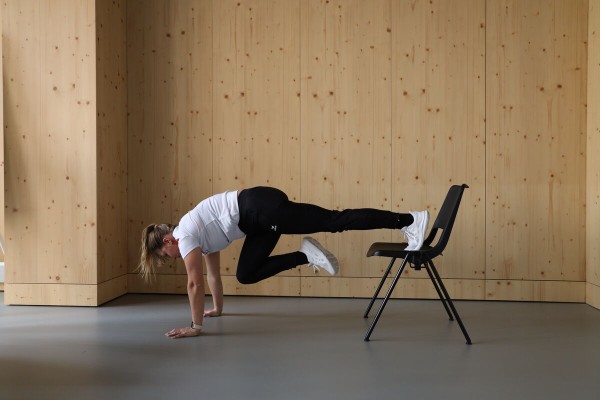
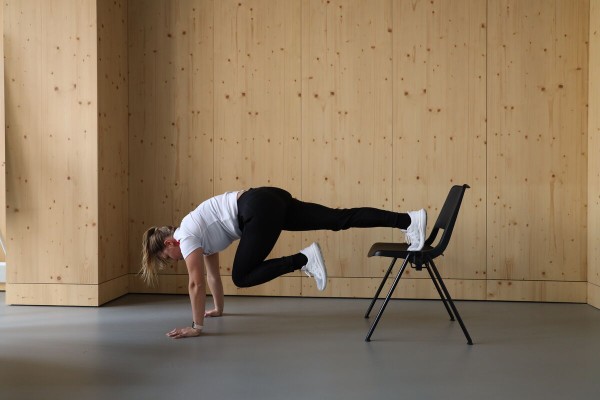
Push-up position with your feet placed on the seat of the chair, alternately bring one knee to your arms (chest height)/bend your leg.
Attention:
Head, shoulders, buttocks and feet form a line, no hollow back, actively tense your torso.
1 (office) chair (without castors)
Extension and flexion of one leg in push-up position alternating ► mountain climber
Power
Individual work
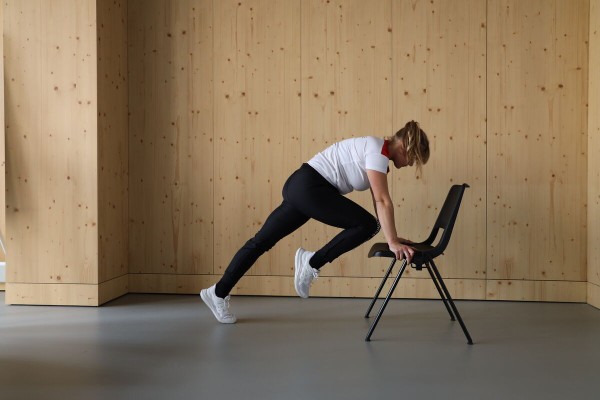
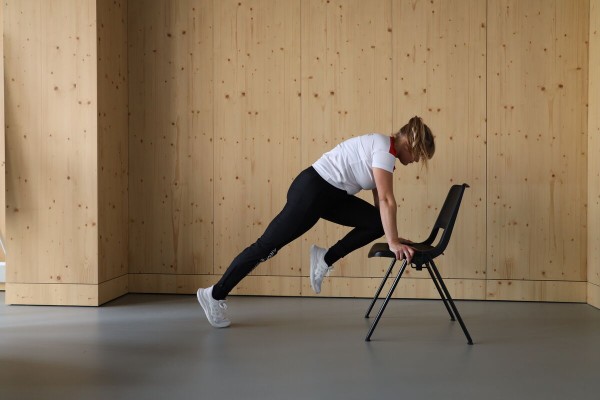
The hands of the almost outstretched arms grip the seat of the chair and support the upper body. The legs are placed well behind the chair so that the body is tilted forwards as in a raised push-up position (head against the backrest). Alternate between lifting one leg off the floor and bringing the knee between the arms (chest height)/bending the leg.
1 (office) chair
Extension and flexion of one leg in push-up position alternating ► mountain climber
Power
Individual work
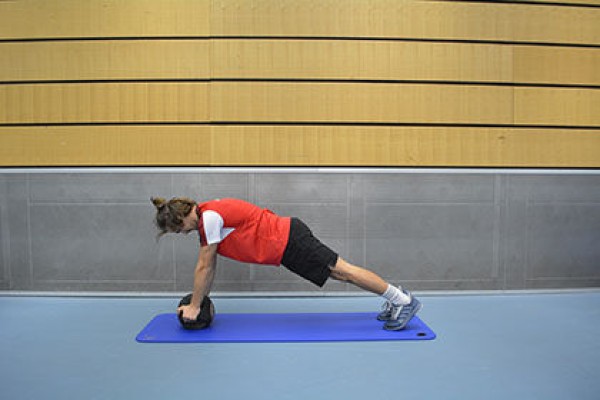

Push-up position with your hands supported on a medicine ball (high support, face/look down), alternately bend one leg and lift it slightly off the floor (bring your knees between your arms/to your chest).
Attention:
Keep your upper body as stable as possible (entire body forms a line from the shoulders to the feet), no hollow back (tense your stomach).
Lighten:
Just hold the basic position (push-up position); barely lift your leg off the floor and/or move it less forwards; perform the exercise without a medicine ball.
Harden:
Additional weight on the legs.
Variant:
Bring your knee diagonally (crosswise) to the opposite arm.
1 medicine ball
2 weight cuffs ► to make the exercise more difficult (additional weight)
Alternating extension and flexion of one leg in push-up position and stretch jump ► mountain climber burpee
Power
Individual work
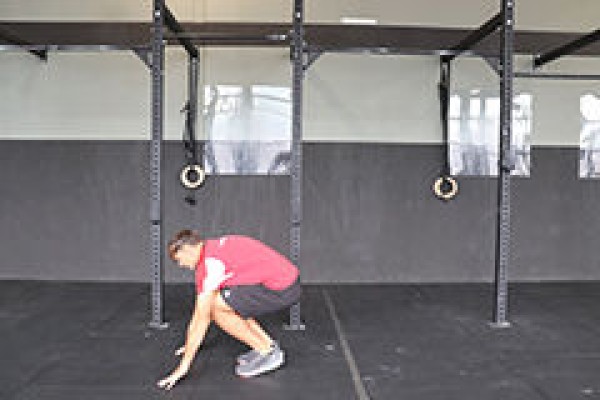
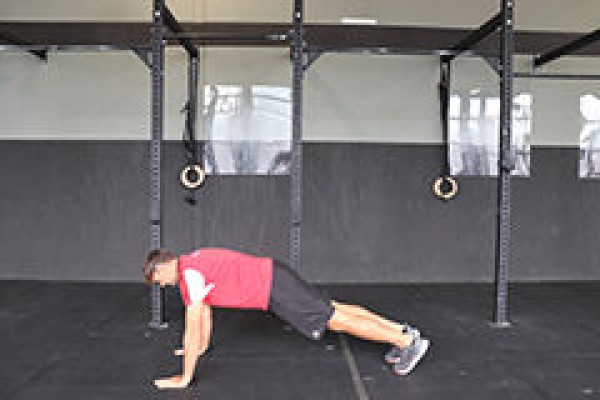
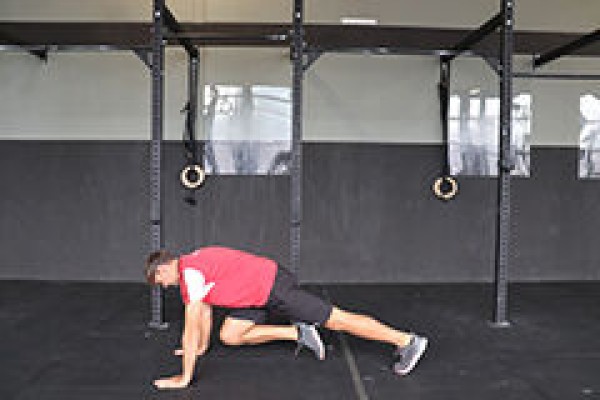
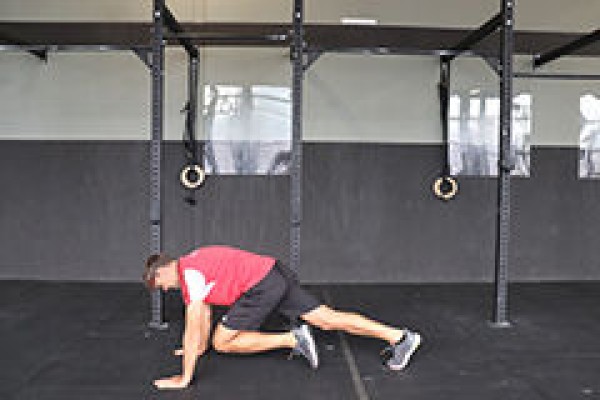
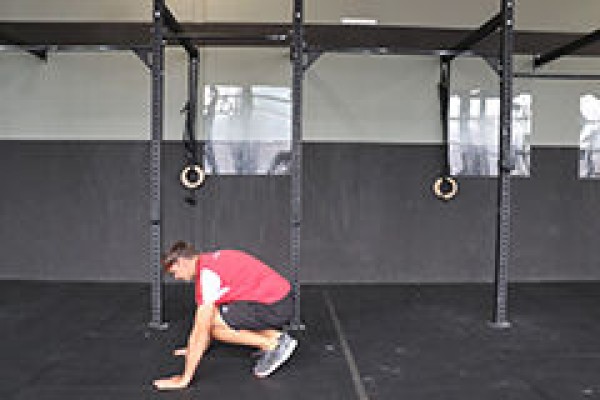
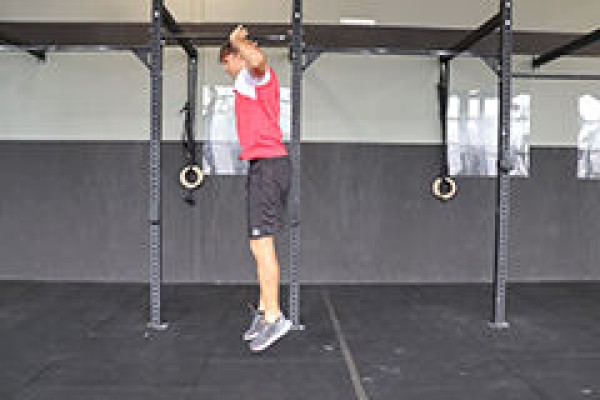
From a standing position, bend your legs, place your hands in front of your feet and hop backwards with both legs at the same time to get into the push-up position. In the push-up position (high support, face/look down), alternately bend your left and right leg and lift them slightly off the floor (bring your knees between your arms/to your chest). Then jump back forwards with both legs to the starting position. From the squatting position, perform a stretch jump (optionally cross your arms briefly behind your head during the flight phase) and land back in the starting position to restart the exercise.
Attention:
Do not arch your back in the push-up position (body tension).
Lighten:
Lower intensity between the individual exercises; lower height during the stretch jump (or only straighten the upper body); only assume the push-up position without bending the legs alternately or barely lift the legs off the floor or move them less far forwards.
Harden:
Additional weight.
2-4 weight cuffs/1 weight waistcoat ► Make the exercise more difficult (additional weight)
Alternating extension and flexion of one leg in supine position ► leg press
Power
Individual work
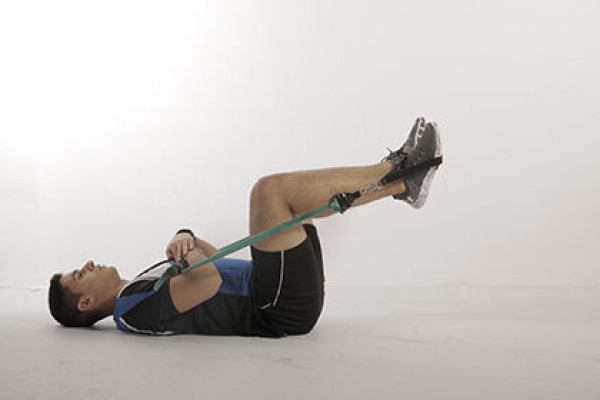
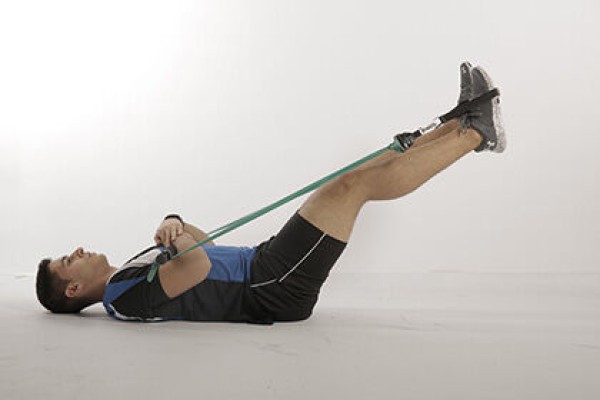
Lie on your back with your legs raised and bent (approximately right angle in the knee joints), your feet are in the loops, hold the gymnastics pole with bent parallel forearms under your sternum (baby position), stretch the elastic bands significantly (wind them up), alternately stretch out one leg (approximately 45 degrees or even horizontally) and pull back to the starting position.
Attention:
Actively tense your abdomen, the lower back must not lift off the floor (no hollow back).
Lighten:
Select less strong elastic bands; roll up the elastic bands less.
Harden:
Choose stronger elastics; roll up the elastics more.
Variant:
Stretch out your legs at the same time (keep your feet in a slight V-position).
1 gymnastic bar with elasticated straps
Extension and flexion of one leg in supine position alternating ► lying bent knee leg raise / alternating knee raise / lying single knee raise
Power
Individual work
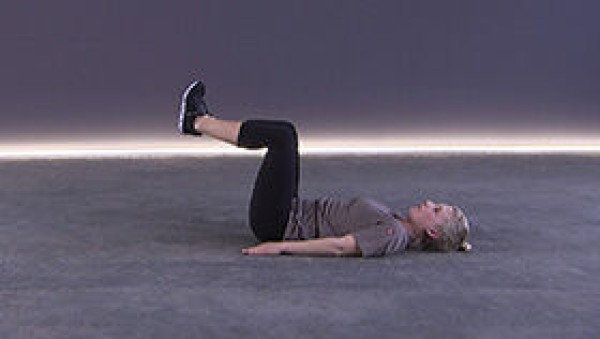
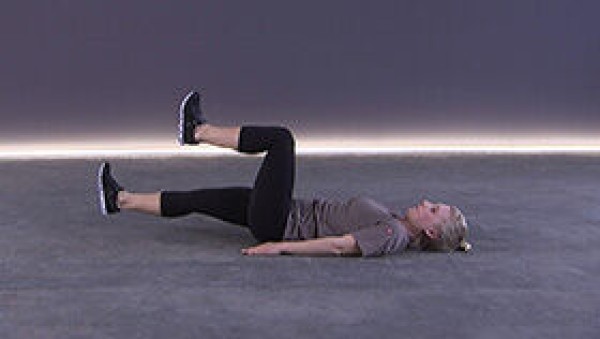
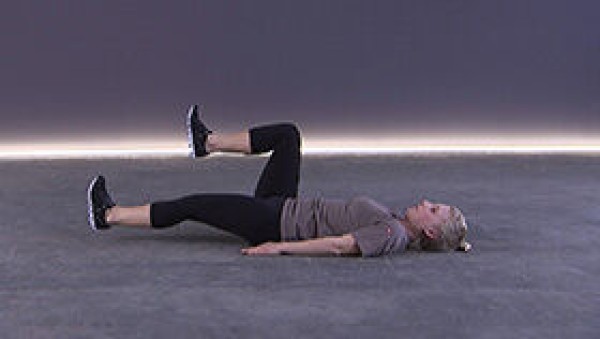
Lying on your back, arms at your sides on the floor or on your body, lower back (lumbar spine) pressed towards the floor, one leg bent and held high (lower leg parallel to the floor, thigh approx. 90 degrees to the body), the other leg stretched out and slightly raised from the floor, alternate the position of the legs (bend/bend one leg, stretch out the other).
Attention:
Keep your back in constant contact with the floor (no hollow back, consciously tense your stomach), do not put your legs down.
Lighten:
Lower your legs less.
Harden:
Add weight to your legs.
2 weight cuffs ► Make the exercise more difficult (additional weight)
Extension and flexion of one leg in supine position alternating ► lying bent knee leg raise / alternating knee raise / lying single knee raise
Power
Individual work
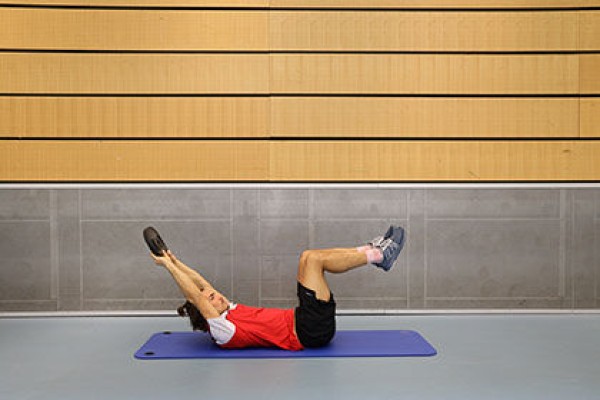
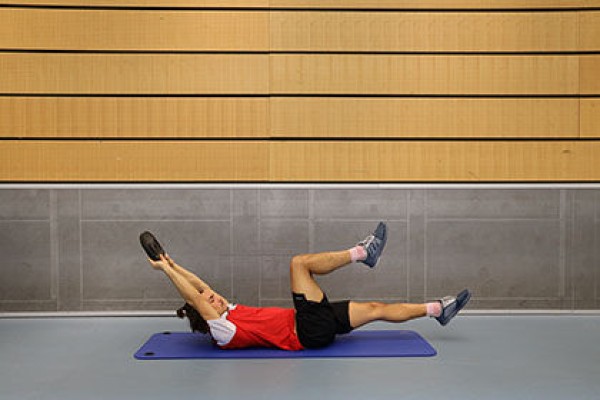
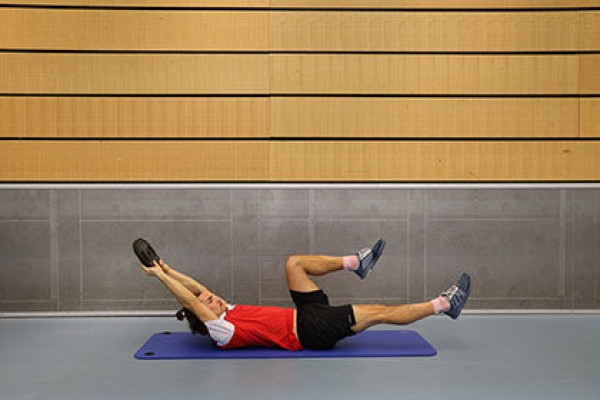
Lie on your back with your upper body slightly raised (shoulder blades lifted off the floor), legs bent and held high (slightly more than 90 degrees at the knee joint, lower legs parallel to the floor), outstretched arms pointing slightly backwards at an angle, grasp the weight with both hands. Extend one leg and return to the starting position. Switch sides after each exercise.
Attention:
Always keep your shoulder blades off the floor (constant tension), do not put your outstretched leg down, keep your head in a neutral position (no double chin).
Lighten:
Hold your arms at chest height or even further forwards; do not hold any additional weight in your hands; extend your leg less close to the floor.
Harden:
Hold your arms further back at an angle; more weight.
1 weight disc
Extension and flexion of one leg in supine position alternating ► lying bent knee leg raise / alternating knee raise / lying single knee raise
Power
Individual work
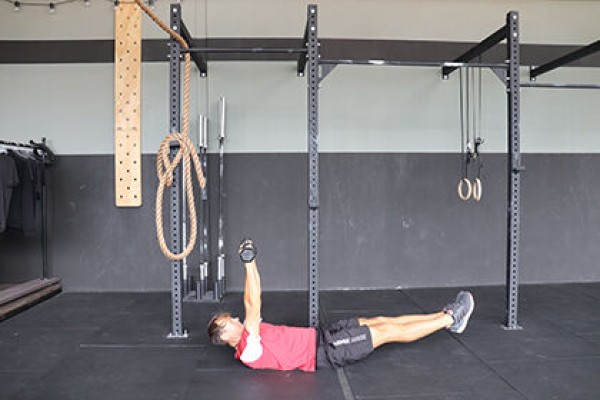
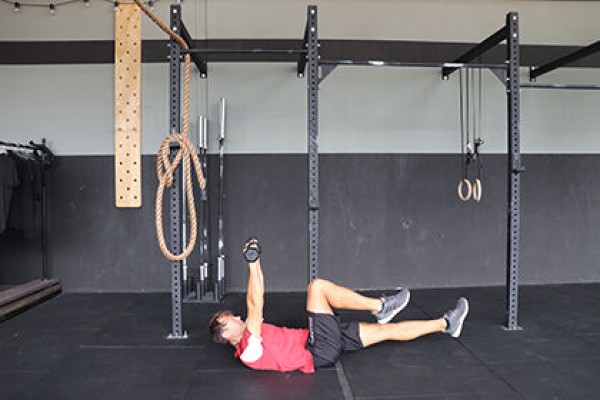
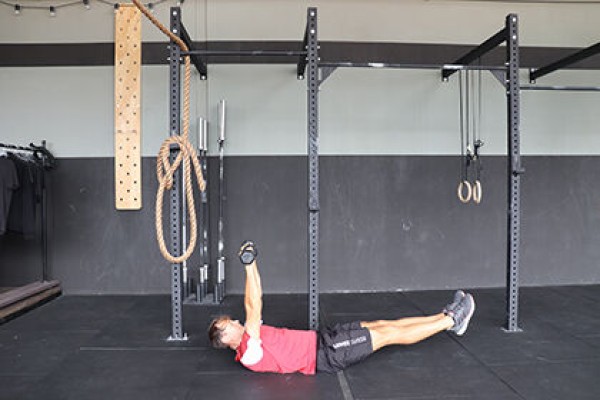
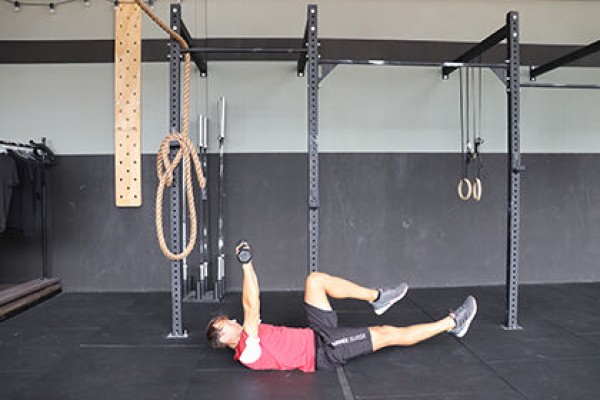
Lie on your back, legs stretched out in extension of the body slightly raised from the floor, lower back (lumbar spine) pressed towards the floor, grasp the weights (2 dumbbells, 1 kettlebell or weight disc) with both hands, arms stretched out at chest height pointing upwards (in front of you), with the shoulder blades slightly detached from the floor. Bend one leg (lower leg parallel to the floor, thigh approximately 90 degrees to the body) and stretch back to the starting position. Switch sides after each exercise.
Attention:
Keep your back in constant contact with the floor (no hollow back, consciously tense your stomach), do not put your legs down.
Lighten:
Lift your legs further off the floor in the starting position; lower your legs completely after each repetition; do not hold any weight in your arms or bring your arms to the floor at the side of your body.
Harden:
Additional weight for the legs.
2 dumbbells/1 weight disc/kettlebell
2 weight cuffs ► Make the exercise more difficult (additional weight)
Extension and flexion of one leg in supine position alternating ► lying bent knee leg raise / alternating knee raise / lying single knee raise
Power
Individual work
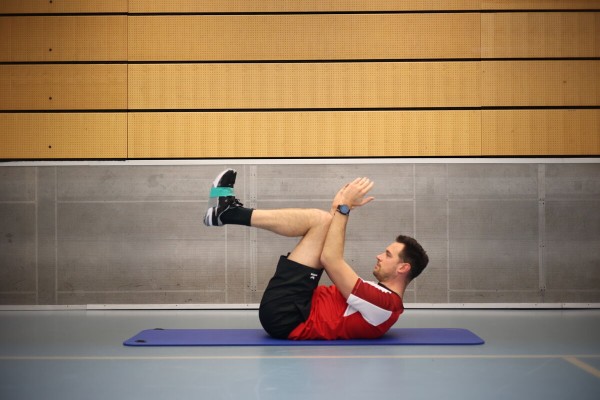
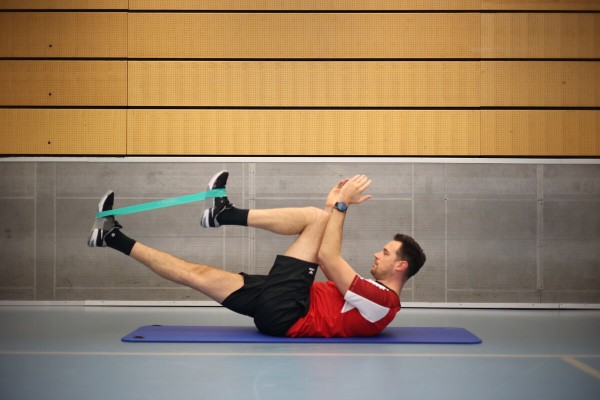
Lie on your back with your shoulders raised off the floor and your outstretched arms pointing vertically upwards (holding position), your legs are bent so that your lower legs point forwards parallel to the floor and your thighs point diagonally backwards (approx. 45 degree angle at the knee joint). In this position (deadbend), the elbows are close to the knees. An elasticated band is held between the legs (place the band around the outer edge of the foot). Alternately bend the hips and straighten the knee so that the leg is pointing diagonally forwards in extension of the body.
Attention:
Do not fully lower the shoulder blades.
Lighten:
Choose an elastic band with less resistance.
Harden:
Choose an elastic band with greater resistance.
1 mini-band
Extension and flexion of one leg in supine position alternating ► lying bent knee leg raise / alternating knee raise / lying single knee raise
Power
Individual work
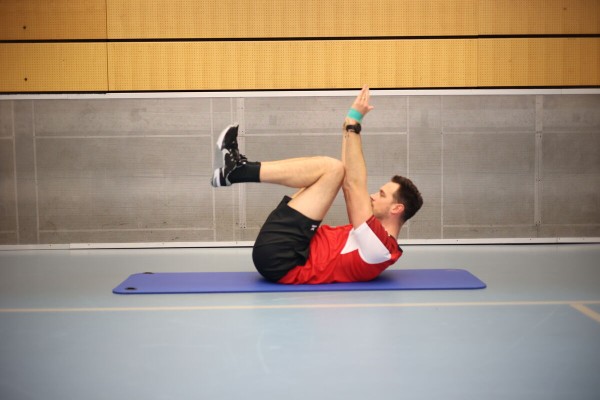
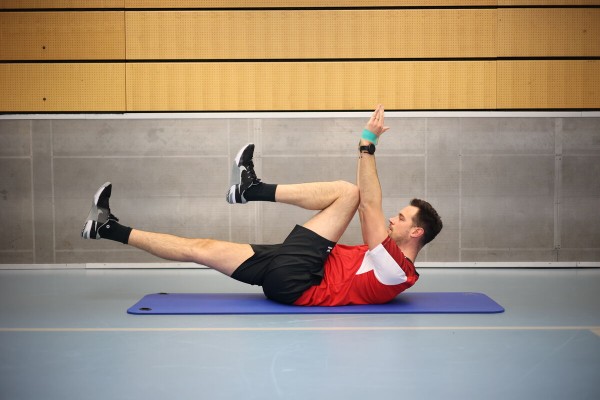
Lie on your back with your shoulders raised off the floor and your outstretched arms pointing vertically upwards (holding position), your legs are bent so that your lower legs point forwards parallel to the floor and your thighs point diagonally backwards (approx. 45 degree angle at the knee joint). In this position (deadbend), the elbows are close to the knees. An elasticated rubber band is held between the arms (place the band around the edges of the hands/wrists), with the arms/shoulders constantly pressed apart (external rotation of the shoulders). Alternately bend the hips and straighten the knee so that the leg is pointing diagonally forwards as an extension of the body.
Attention:
Do not fully lower your shoulder blades; consciously push your shoulders outwards.
Lighten:
Lower your legs less.
Harden:
Add weight to your legs.
1 mini band
2 weight cuffs ► to make the exercise more difficult (additional weight)
Extension and flexion of one leg in supine position alternating ► lying bent knee leg raise / alternating knee raise / lying single knee raise
Power
Individual work
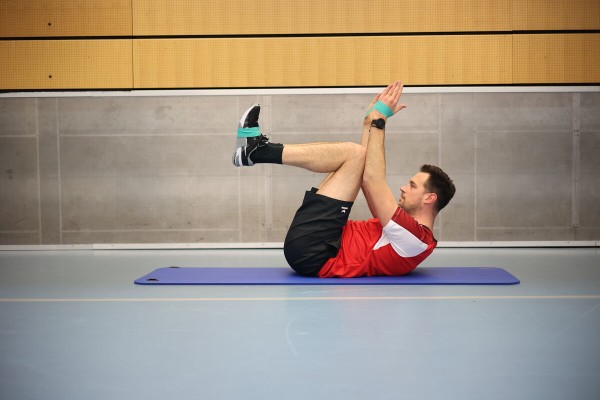
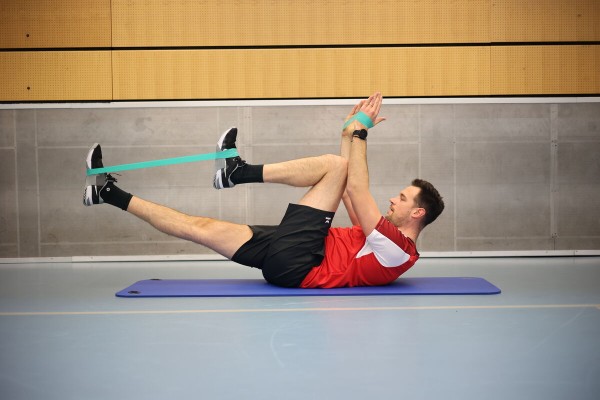
Lie on your back with your shoulders raised off the floor and your outstretched arms pointing vertically upwards (holding position), your legs are bent so that your lower legs point forwards parallel to the floor and your thighs point diagonally backwards (approx. 45 degree angle at the knee joint). In this position (deadbend), the elbows are close to the knees. An elasticated rubber band is held between the arms (place the band around the edges of the hands/wrists), whereby the arms/shoulders are always pressed apart (external rotation of the shoulders). An elasticated band is also held between the legs (place the band around the outer edge of the foot). Alternately bend your hips and straighten your knee so that your leg is pointing diagonally forwards as an extension of your body.
Attention:
Do not fully lower the shoulder blades; consciously push the shoulders outwards.
Lighten:
Select an elastic band with less resistance.
Harden:
Select an elastic band with greater resistance.
2 mini ribbons
Extension and flexion of one leg in supine position alternating ► lying bent knee leg raise / alternating knee raise / lying single knee raise
Power
Individual work
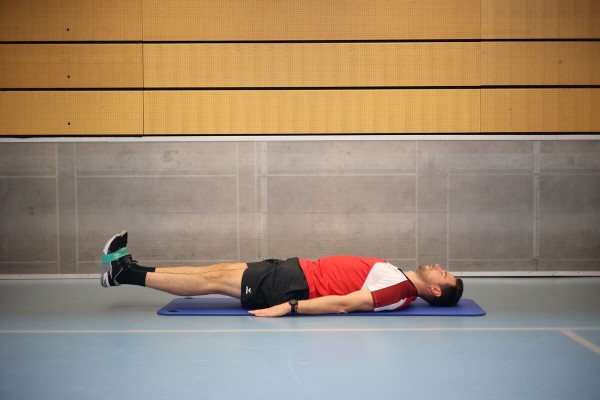

Lie on your back with your arms flat on the floor at your sides (or place your hands under your buttocks/or clasp your hands behind your head), your outstretched legs slightly raised off the floor, stretch an elasticated band between your legs (place the band around the instep/soles of your feet). From this position, alternately bend one leg (lower leg practically parallel to the floor, upper leg approx. 90 degrees to the body - one-sided hip flexion) and stretch back to the starting position.
Attention:
Keep your back in constant contact with the floor (no hollow back, consciously tense your stomach), do not put your legs down.
Lighten:
Choose an elastic band with less resistance.
Harden:
Choose an elastic band with more resistance.
1 mini-band
Extension and flexion of one leg and arm in supine position alternating ► dead bug
Power
Individual work
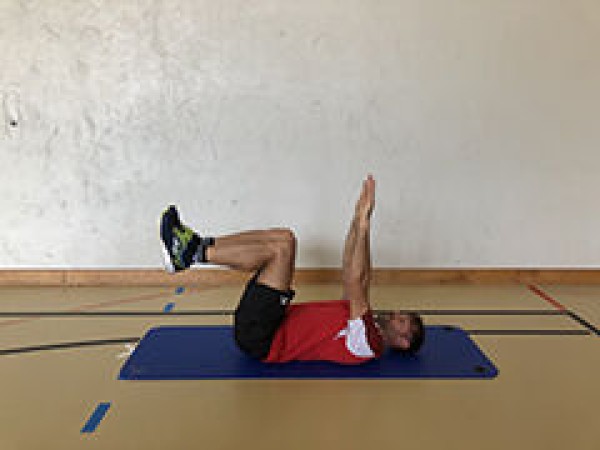
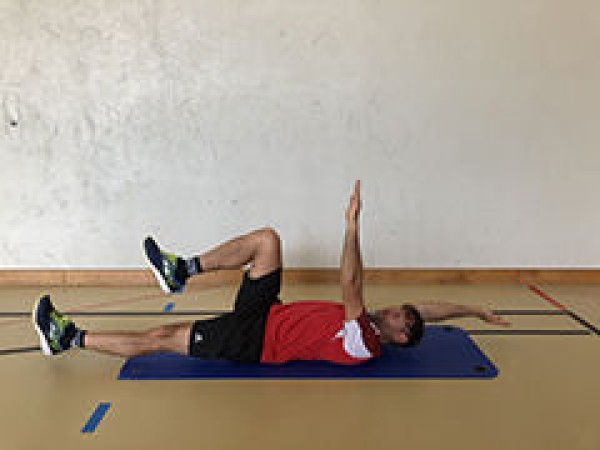
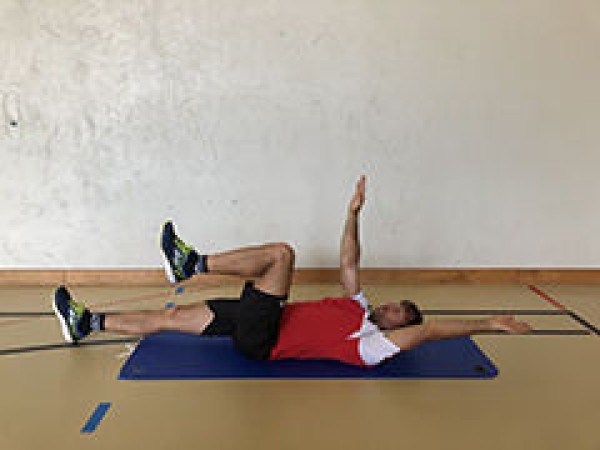
Lie on your back, arms in front of your chest (pointing upwards), legs bent and held high (approximately 90 degrees at the knee joint, thighs pointing upwards, lower legs parallel to the floor). Extend one arm and one leg crosswise in extension of the body (without lowering them to the floor), then return the leg and arm to the starting position. Switch sides after each exercise.
Attention:
Never lower your extremities completely; your lower back should always be in contact with the floor (no hollow back, consciously tense your stomach).
Lighten:
Lower your arm and leg less.
Harden:
Additional weight for the arms/legs.
2-4 weight cuffs/2 weight balls/dumbbells ► Make the exercise more difficult (additional weight)
Extension and flexion of one leg and the arms in supine position alternating ► dead bug
Power
Individual work

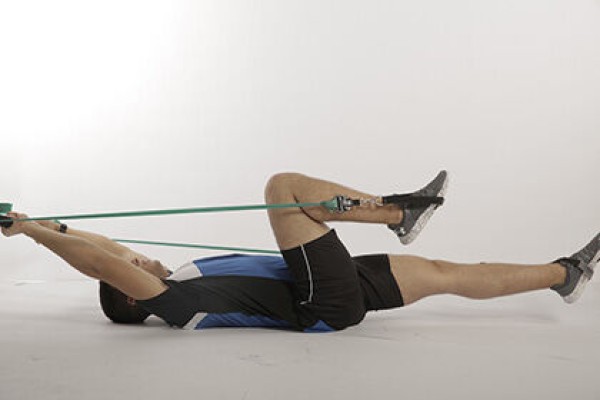
Lie on your back with your legs raised and bent (approximately right angle in the knee joints), your feet are in the loops, the gymnastics bar is held with both hands at chest height (backs of hands pointing towards the floor), alternately stretch both arms and one leg each against the resistance of the elastic bands in extension of the longitudinal axis of the body and return to the starting position.
Attention:
Actively tense your abdomen, the lower back must not lift off the floor (no hollow back).
Lighten:
Choose less strong elastic bands; roll up the elastic bands less.
Harden:
Choose stronger elastic bands; roll up the elastic bands more.
1 gymnastic bar with elasticated straps
Extension/protraction of the neck in standing, sitting or supine position
Power
Individual work
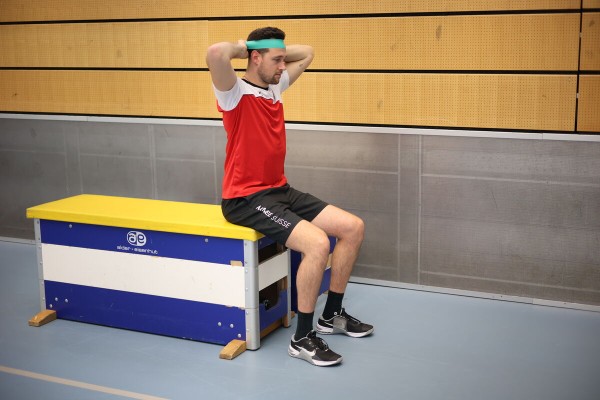
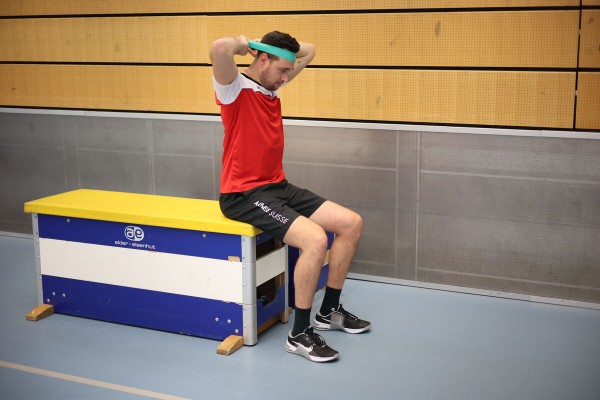
While standing upright, sitting or lying on your back, place an elasticated band around your forehead and hold/fix it behind your head with the hands of your bent arms (clasp your hands behind your head, elbows at head height). Tilt your head forwards to stretch/tension the band and lift it back to the neutral starting position (neck extension/protraction).
Attention:
Movement takes place exclusively in the neck (upper body and arms remain stable).
Lighten:
Select a rubber band with less resistance.
Harden:
Select a rubber band with greater resistance.
1 mini band
1 seating option (e.g. chair, plyo box or vaulting box) ► depending on the starting position
Bring heel to buttocks in jump ► bottom kick
Power
Individual work
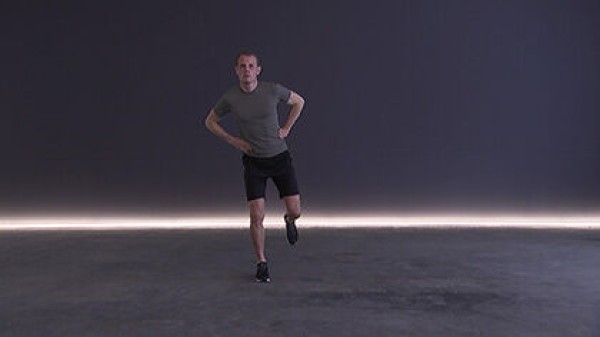

Stand upright in a slight straddle position (starting position, then single-leg stance), alternately pull the heel up to the buttocks while jumping (bouncing slightly from one leg to the other), arms supported on the hips, crossed in front of the chest or in front of the body.
Attention:
Maintain upright position (body tension).
Lighten:
Exercise while standing (without jumping).
Harden:
Add weight (hold on the legs, shoulders or in the hands).
Variant:
Pause between jumps (stand completely, maintain balance) or jump continuously.
2 weight cuffs/1 weight vest/weight disc/sandbag/fighting backpack/1-2 dumbbells ► Make the exercise more difficult (additional weight)
Flexion of the arms in handstand ► negative handstand push up
Power
Individual work
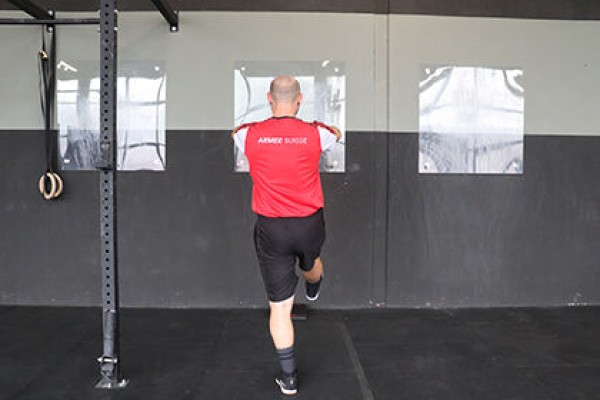

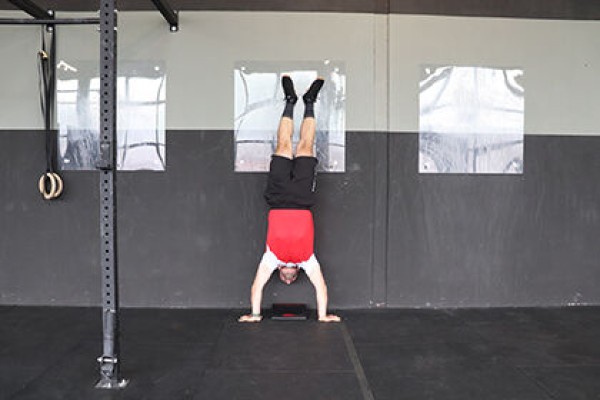
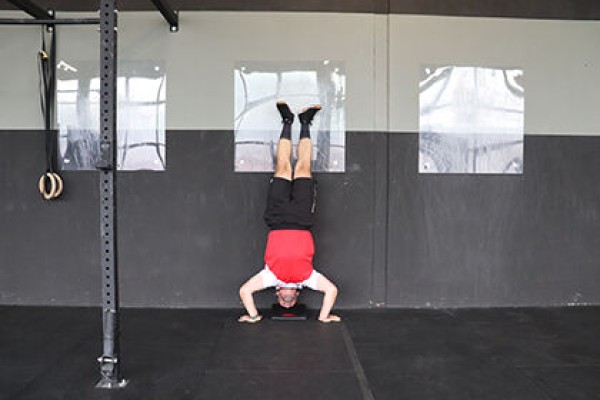
Stand upright in front of a wall (facing the wall), bring your arms to the floor close to the wall and move one leg at a time from a stepping position to the wall with momentum, place your heels against the wall to be able to hold yourself in the handstand (full body stretch, arms overhead in a high position). From this position, bend your arms very slowly and bring your head/body towards the floor. Once in the headstand position, bring the legs back to the standing position.
Attention:
Lower the upper body in a controlled manner.
Lighten:
Bend the arms slightly and bring the legs back to the standing position before the final position in the headstand.
Harden:
Additional weight (on the feet).
1 wall
2 weight cuffs/1 weight waistcoat ► Make the exercise more difficult (additional weight)
Flexion of the arms in the hang ► chin over bar hold
Power
Individual work
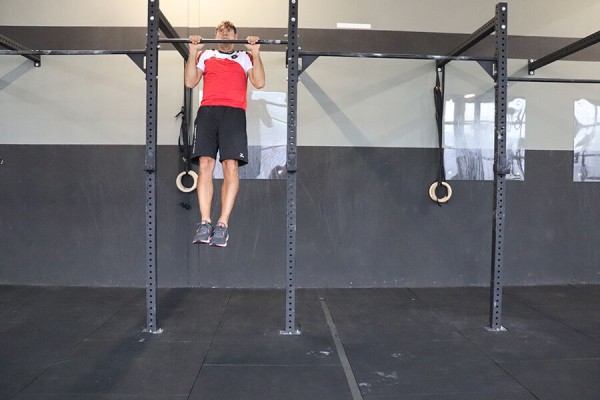
When hanging on the horizontal bar (upper grip, back of hands pointing backwards), arms bent so that the chin is at or above the horizontal bar (arms at least at shoulder height), hold the position (elbows close to the body, legs stretched).
Attention:
Keep the whole body as stable as possible (body tension, no swinging/swaying).
Lighten:
Attach an elasticated band to the bar to place one or both feet in its loop.
Harden:
Additional weight.
Variation:
Grab the bar with an underhand grip (palm facing your face).
1 horizontal bar
1 elasticated rubber band ► Make the exercise easier (support)
2 weight cuffs/1 weight waistcoat ► Make the exercise more difficult (additional weight)
Flexion of the arms on the slope ► negative pull up
Power
Individual work
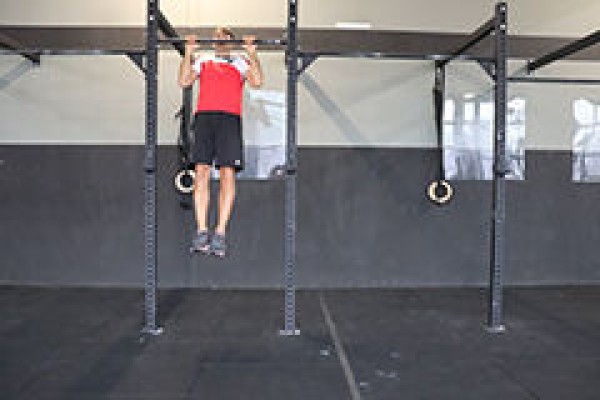

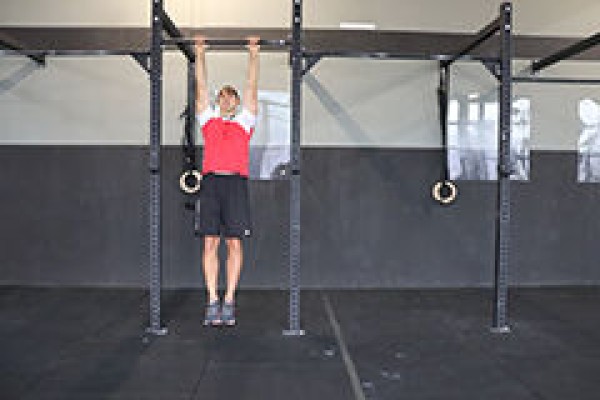
When hanging from the horizontal bar (upper grip, back of hands pointing backwards), bend your arms so that your chin is level with the horizontal bar (arms almost at shoulder height) and slowly stretch your arms to lower your body towards the floor in a controlled manner until your arms are finally fully extended overhead (passive hang, full body stretch).
Attention:
Keep the whole body as stable as possible (body tension, no swinging/swaying).
Lighten:
Attach an elasticated band to the horizontal bar to place one or both feet in its loop.
Harden:
Additional weight.
Variant:
Grab the bar with an underhand grip (palm facing your face).
1 horizontal bar
1 elasticated rubber band ► Make the exercise easier (support)
2 weight cuffs/1 weight waistcoat ► Make the exercise more difficult (additional weight)
Lateral flexion of the neck in standing, sitting or supine position (left)
Power
Individual work
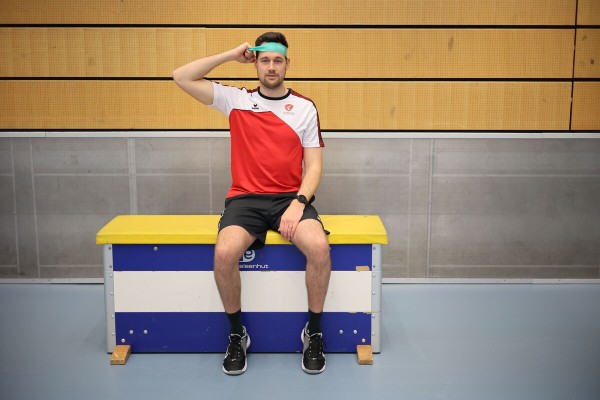
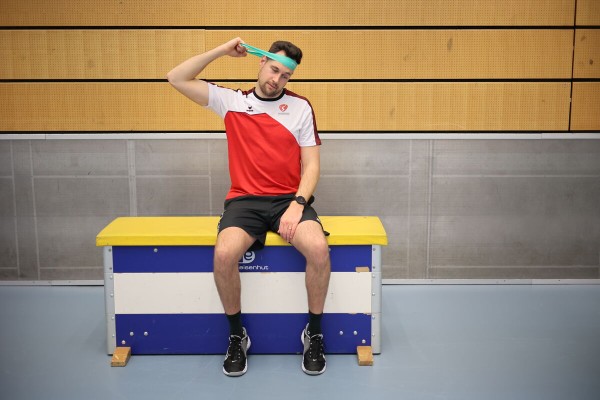
When standing upright, sitting or lying on your back, place an elasticated band around your forehead and hold/fix it with the (right) hand of your bent arm (elbow pointing to the side) to the side of your head at ear level. Tilt the head to the (left) side to stretch/tension the band and return to the neutral starting position (lateral neck flexion).
Attetnion:
Movement takes place exclusively in the neck (upper body and arm remain stable).
Lighten:
Choose a rubber band with less resistance.
Harden:
Choose a rubber band with greater resistance.
1 mini band
1 seating option (e.g. chair, plyo box or vaulting box) ► depending on the starting position
Lateral flexion of the neck in standing, sitting or supine position (right)
Power
Individual work
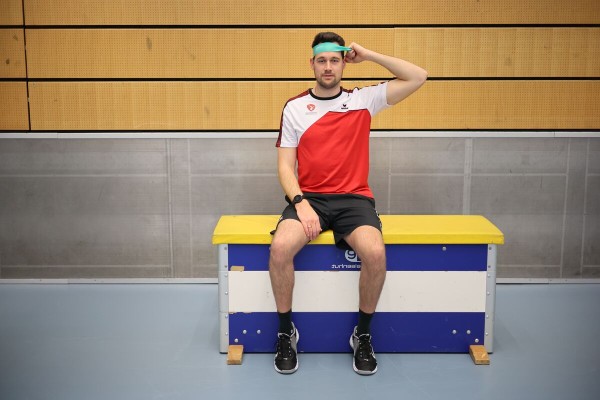
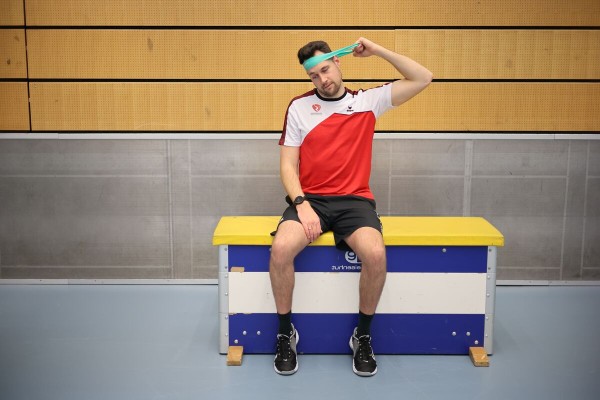
When standing upright, sitting or lying on your back, place an elasticated band around your forehead and hold/fix it with the (left) hand of your bent arm (elbow pointing to the side) to the side of your head at ear level. Tilt the head to the (right) side to stretch/tension the band and return to the neutral starting position (lateral neck flexion).
Attention:
Movement takes place exclusively in the neck (upper body and arm remain stable).
Lighten:
Choose a rubber band with less resistance.
Harden:
Choose a rubber band with greater resistance.
1 mini band
1 seating option (e.g. chair, plyo box or vaulting box) ► depending on the starting position
Flexion and extension of the arms in handstand ► handstand push up
Power
Individual work
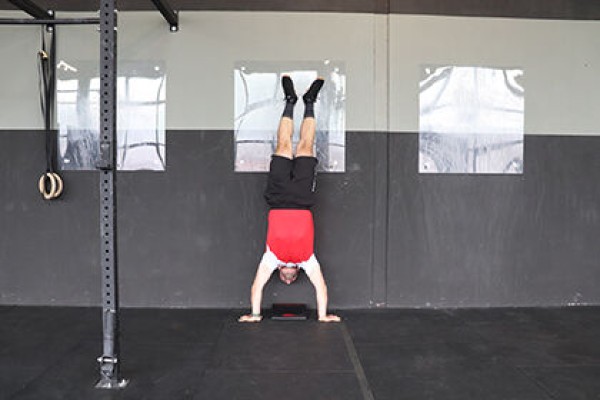
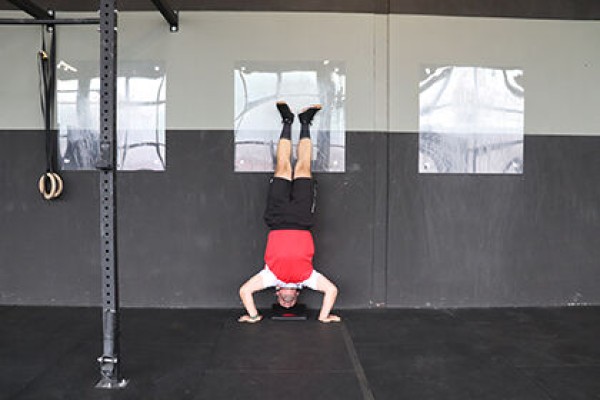
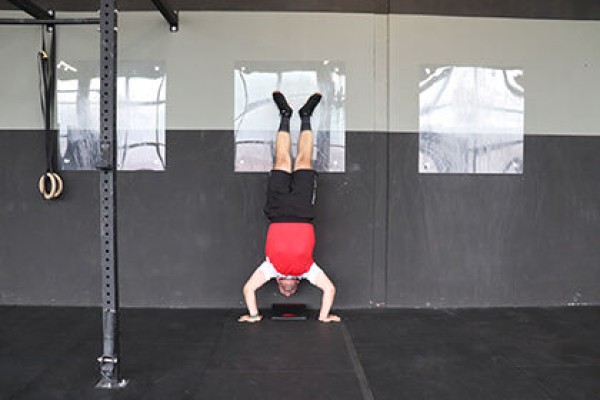
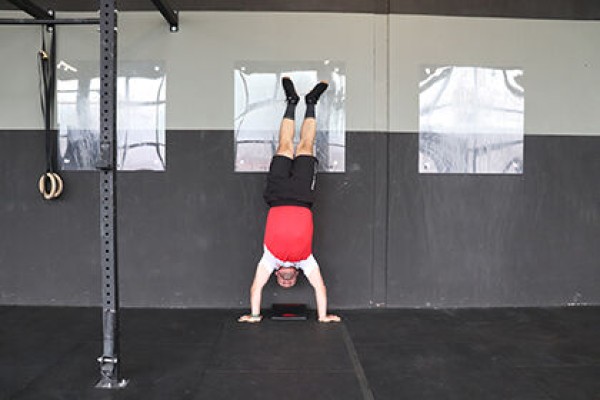
Handstand against a wall, facing away from the wall and holding the position by placing your heels against the wall. Bend your arms until your head practically touches the floor (lower your body) and stretch back to the handstand (full body stretch, arms stretched and held high).
Attention:
Lower and raise your upper body in a controlled manner.
Lighten:
barely bend your arms; support the lifting of the upper body with your legs by bending them and pushing them upwards.
Harden:
additional weight (on your feet).
1 wall
2 weight cuffs/1 weight waistcoat ► Make the exercise more difficult (additional weight)
Flexion/retraction of the neck in standing, sitting or supine position
Power
Individual work
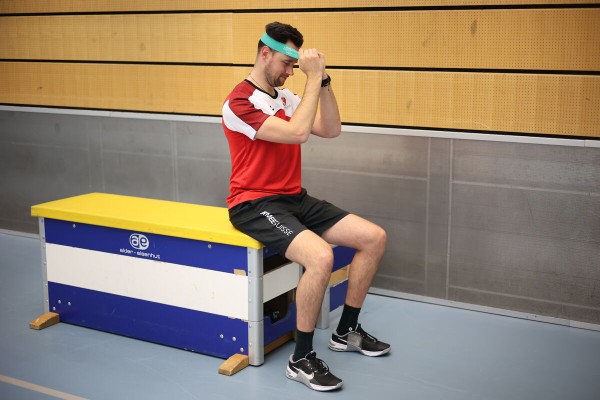

When standing upright, sitting or lying on your back, place an elasticated band around your forehead and hold/fix it with the hands of your bent arms in front of your head (elbows at chest height, hands placed in front of your forehead). Tilt your head slightly forwards and backwards to stretch/tension the band and return to the starting position (neck flexion/retraction).
Attention:
Movement only takes place in the neck (upper body and arms remain stable).
Lighten:
Choose a rubber band with less resistance.
Harden:
Choose a rubber band with greater resistance.
1 mini band
1 seating option (e.g. chair, plyo box or vaulting box) ► depending on the starting position
Flying elbows while standing ► fly
Power
Partner work
1 trainee & 1 helper ► Note change of position
(= double the time required; for lesson planner see Organisation Kraft: Info button Execution)
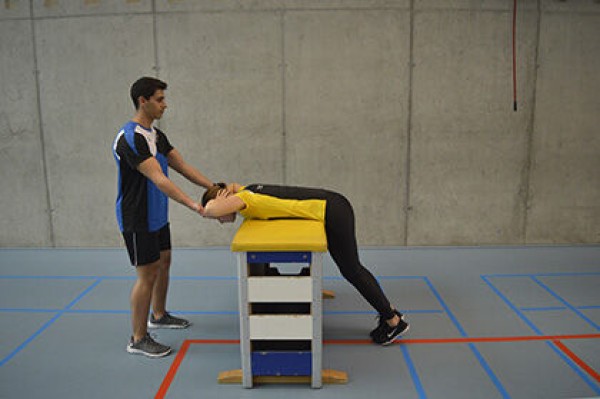
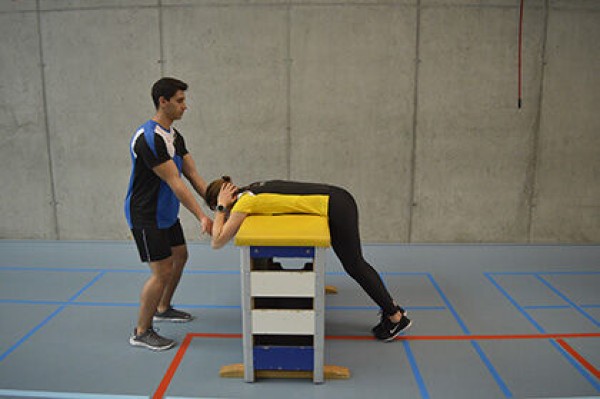
Trainee: Standing, support the upper body on the vaulting box, clasp your hands behind your head (elbows pointing to the side), bring your elbows together in front of your head (in the direction of your gaze) and back to the starting position.
Partner: Stands on the opposite side of the vaulting box, holds the elbows against the movement of the active participant (pulls upwards/outwards).
Attention:
Always listen to/respond to the partner (adjust pressure/resistance). Elbows are at shoulder height or slightly below.
Lighten:
Less pressure/resistance from your partner.
Harden:
More pressure/resistance from your partner.
1 swing box (3-4 elements incl. top section)